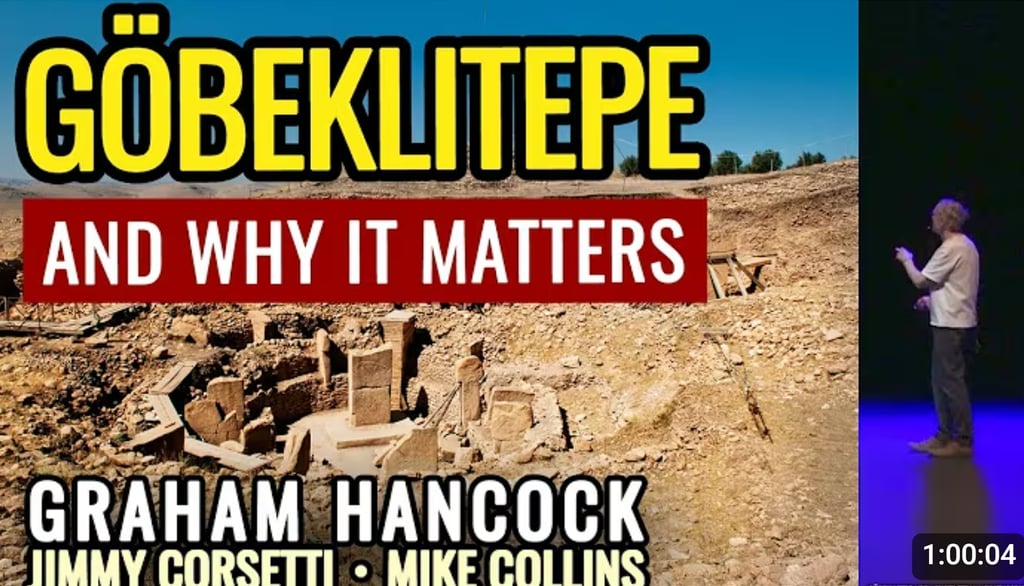Why 1200-Ton Megablocks Were Never Transported — And What Really Happened
How were ancient stones too massive for modern cranes placed with millimeter precision? This article challenges the mainstream view of megalithic construction and introduces a field-based model of matter — where form arises not by force, but by coherence.
POPULAR
Paul Hager
6/29/20255 min read


A STONE SO MASSIVE IT SILENCES THE MIND
You look. And you can’t quite believe it.
In the recent video Göbekli Tepe and Why It Matters — a 2025 presentation by Graham Hancock in Sedona, Arizona — you see footage of something that should not exist:
a massive, perfectly rectangular block of stone in Baalbek, Lebanon.
Larger than a city bus. Straighter than a carved tombstone.
Over 20 meters long. Weighing an estimated 1200 tons.
They speak about it as if it’s just another historical marvel.
But you can hear the wonder in their voices:
“We couldn’t move this today — not even with our most advanced cranes.
Let alone place it at a height of seven meters, with millimeter precision.”
And yet it’s there.
Lying in place, as if it had always been there.
Or — more strangely — as if it had arrived without ever having moved.
What if that last idea isn’t just possible...
but exactly what happened?
What follows is not an explanation within our current paradigm.
What follows is a redefinition of matter itself.
A model in which stones do not need to be transported —
because they emerge from the field.
Where everything converges: direction, tension, circulation, and coherence.
WHY 1200-TON MEGABLOCKS WERE NEVER TRANSPORTED — AND WHAT REALLY HAPPENED
They’re there.
Massive blocks of stone.
Some weigh over a thousand tons — enough to anchor a skyscraper.
And yet they lie on site as if placed gently by tweezers.
Take Baalbek. A temple complex in modern-day Lebanon.
Three of the largest stones ever used in construction, each weighing between 800 and 1200 tons, are stacked into a wall taller than a two-story house.
Perfectly aligned. Millimeter fit. No mortar. No gaps.
There are no traces of cranes.
No sleds. No roads. No transport infrastructure.
And still, history says:
“They moved them.”
The Four Assumptions We’ve Made
Conventional narratives assume the following sequence:
The stone was located elsewhere
Humans quarried it
Humans transported it
Humans placed it
But none of these four steps are supported by conclusive evidence.
– No transport paths have ever been found
– No tools exist that could lift or move such weight
– No explanation accounts for the precision of placement, beyond modern capabilities
What if the sequence is wrong?
What if it didn’t start with a stone being moved...
but with a place that wanted to take form?
The Field as the Source of Form
In the scientific paper Matter as Stabilized Field Tension (Hager, 2025), a different model of substance is proposed:
Matter is not a thing.
It is the result of stable tension within a field.
This field is defined by four parameters:
– ∇Φ: the gradient of tension — where field energy flows or converges
– Ω: circulation topology — whether tension rotates, repeats, or locks
– λ: coherence index — how stable the field remains through time and disturbance
– μ: modulation sensitivity — how reactive the field is to fluctuations
When all four align within certain thresholds, something unusual happens:
The field locks.
Form holds.
Matter emerges as stabilized tension.
“Substance is not what is, but what persists coherently as structured difference — a recursive equilibrium of field dynamics.”
(Matter as Stabilized Field Tension, p. 9)
In simpler terms:
Matter appears when tension holds its shape.
Not by assembling atoms, but by structuring field gradients.
So what does this mean for megaliths?
If a stone is not a thing, but a field structure,
we shouldn’t ask:
“How was it moved?”
We should ask:
“How did the field at this location become so stable that it could carry matter?”
That is the mystery of megalithic architecture.
What We See at Baalbek and Göbekli Tepe
At sites like Baalbek and Göbekli Tepe, this is exactly what we observe:
– ∇Φ converges — natural tension lines meet in the terrain
– Ω is closed — in spirals, circles, and looped geometries
– λ rises — through rhythm, proportion, and group resonance
– μ drops — the field is undisturbed, acoustically clean
The result?
Matter condenses at that location.
Not by falling from the sky — but by stabilizing as shape.
Not moved. Formed.
Göbekli Tepe Was Not a Temple — It Was a Field Device
Göbekli Tepe, conventionally dated to around 9600 BCE, is one of the oldest and most puzzling megalithic sites on Earth.
Its significance is not just its age or craftsmanship — but the logic behind its design.
Three elements stand out:
Double Circular Structures
Each central unit consists of two concentric circles of pillars.
This isn’t for aesthetics. It’s field mechanics.
Two closed loops reinforce Ω — the rotational structure of the field.
Just like in the Noöhedral model, where Ω determines whether form remains.
A single circle closes. A double circle anchors.
Central Pillars
At the heart of each structure stand two monumental T-shaped columns.
They face each other with a subtle tilt — as if pointing a direction.
These are not load-bearing columns. They are Ψ-projectors.
They define orientation within the field.
In my model, no stable ∇Φ exists without Ψ — and no mass without ∇Φ.
The pillars don’t support weight.
They support direction.
And that direction shapes the field into form.
Animals as Directional Relays
On the pillars are carved animals — foxes, snakes, birds, scorpions.
Not randomly placed. Not just symbolic.
They are positioned with purpose.
Each creature has a field character:
– Snake = spiral tension
– Fox = lateral shift
– Bird = vertical axis
Their presence modulates the field locally —
enhancing or disrupting gradients, opening or sealing Ω-cycles.
They’re not decorations. They’re field modulators.
Göbekli Tepe is not a shrine.
It is a resonance array.
What Did People Actually Do?
They didn’t build as we do.
They didn’t use tools.
Their instruments were direction, rhythm, and repetition.
They stood in circles.
They sang tones that shaped the field.
They placed stones not to construct, but to code tension into the ground.
They walked patterns.
They used breath, drums, silence.
Their task was coherence-building:
– through movement: walking rhythmically
– through geometry: placing by proportion
– through sound: creating harmonic resonance
– through attention: timed precisely
They didn’t force the field.
They aligned with it —
so it could speak.
How Old Is It Really?
While conventional dating places Göbekli Tepe around 9600 BCE, several indicators suggest its origins may reach far deeper.
The lowest layers contain no datable organic remains.
The precision and design reflect a civilization already fluent in field mechanics.
In Noöhedral terms:
This may not be the beginning of something.
But the end — the high point — of a long-standing tradition of field-coherent architecture.
A peak.
Followed by a closure — not from collapse, but from reverence.
Why These Locations?
Megaliths don’t appear randomly.
They emerge at sites where the Earth’s own field already supports form.
Baalbek, Göbekli Tepe, and Stonehenge all lie on:
– intersections of natural tension lines
– acoustically or electromagnetically active terrain
– landscape nodes like plateaus and ridges
– celestial alignments (Sirius, Orion, solstices)
These places buzz with form potential.
In field terms:
– ∇Φ naturally converges
– Ω is nearly closed
– λ can be raised with minimal effort
– μ is low — little environmental interference
These were not convenient locations.
They were permissive ones.
The land itself gave consent.
Why Such Massive Blocks?
Precisely because such masses are impossible by normal standards.
High λ and stable Ω allow larger forms to hold together.
This is literally encoded in the physics of my model:
mass ∼ |∇Φ ⋅ Ω| ⋅ λ
(p. 14)
So we see stones of 800 to 1200 tons.
Not because anyone could lift them.
But because the field could sustain them.
Mass, here, is not weight.
It’s a measure of tension density.
What Does This Mean for History?
It means our view of the past is built on a physics too narrow for the evidence.
We interpret in terms of force and tools.
But these structures whisper another language:
– of resonance
– of alignment
– of coherence
Megaliths are not mysteries.
They are memory.
Not of gods or aliens —
but of our forgotten capacity to partner with the field.
And Today?
Today we look at these stones and say:
Unexplainable.
Because we’ve forgotten what form really is.
But whoever understands that matter is a field phenomenon...
will also understand:
A stone may not have been placed.
It may have appeared —
because everything aligned.
We’ve simply forgotten how it speaks.
Because we stopped listening.
Because we believed we were the source.
The moment a culture believes it is the source of form,
it breaks contact with what gives form.
Not out of ignorance —
but out of arrogance.
That is why it vanished.
What once was listening became control.
Direction (Ψ) was no longer attuned but claimed.
Tension (∇Φ) no longer held but hoarded.
Circulation (Ω) locked into hierarchies.
Coherence (λ) confused with dominance.
And the field fell silent —
not because it ceased to speak,
but because we lost the ability to hear.
Reference
Hager, P. (2025). Matter as Stabilized Field Tension: A Noöhedral Reformulation of Substance. Zenodo. https://doi.org/10.5281/zenodo.15257669
